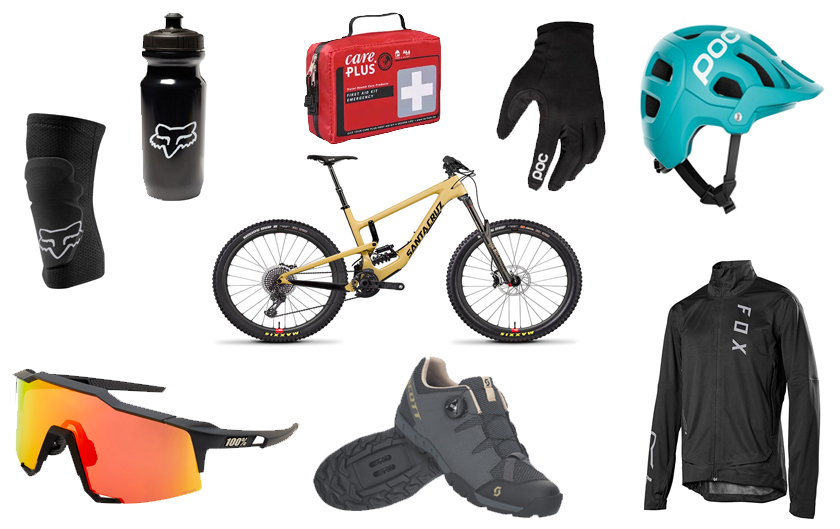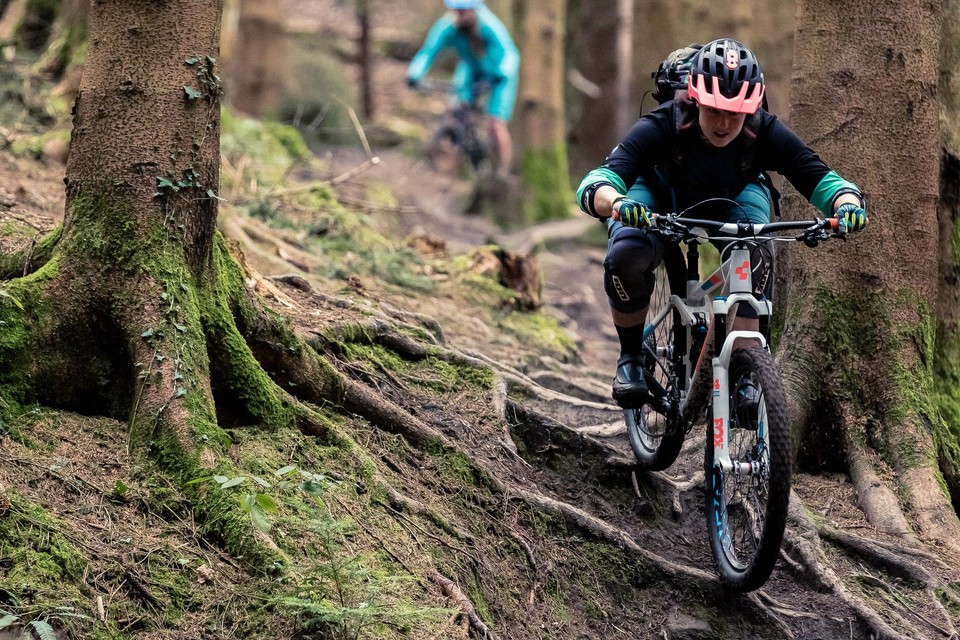


Is downhill mountain biking dangerous? This exciting and adrenaline-fueled sport comes with risks and challenges. Downhill mountain biking involves steep, rough terrain and high speeds, which can lead to injury and possible accidents.
Drivers must have the appropriate skills, experience, and safety equipment to reduce this risk.
Their design for intense performance and handling various terrains makes downhill mountain bikes riskier than other bikes. Riders face the challenges of steep slopes, rock gardens, jumps, drops, and tight turns that require precise riding and quick decision-making.
Read More : ” Why Are Mountain Bikes Heavier Than Road Bikes? ”
Understanding the Thrill: Exploring the Excitement and Adrenaline of Downhill Mountain Biking



Downhill mountain biking is an exciting and fun adventure for riders seeking adrenaline and conquering rough terrain. Here are some key points to consider:
Read More : ” Can You Mountain Bike Without Suspension? “
High-speed Descents:
Downhill mountain biking involves going down a steep slope at high speed, which provides an exciting adrenaline rush.
Terrain Adaptation:
Different terrains like slopes, bumpy surfaces, tree roots, and obstacles make drivers adjust their technique and stay in control.
Equipment and safety:
Mountain biking requires specific equipment to ensure the rider’s safety. This includes a full-face helmet, body armor, and a strong suspension system. These gear items are necessary to protect the rider from bumps and potential injuries.
Physical and Mental Demands:
Cycling downhill tests both physical and mental endurance. Maintaining control and responding to changing track conditions requires strength, balance, and focus.
Risk Management:
Mountain biking is risky, but cyclists can reduce their chances of injury by using proper technique. They can also lower their risk by understanding their abilities and improving with practice.
Remember that safety should always be a priority when mountain biking. Proper preparation, awareness with the track, and following safety rules can help ensure a fun and safe ride. Get ready, enjoy the excitement, and ride responsibly!
Read More : ” How Does Mountain Bike Suspension Work? “
The Risks and Challenges: Examining the Dangers Associated with Downhill Mountain Biking



Downhill mountain biking is an exciting sport that comes with its risks and challenges. Here are some important points to consider:
High-speed Downhill:
Downhill mountain biking involves riding at high speeds, which can increase the risk of crashes and accidents.
Injury Potential:
Downhill mountain biking is riskier than other types of cycling because of the nature of the sport. Common injuries include broken bones, sprains, and abrasions.
Equipment Failure:
Damaged equipment or improper maintenance can lead to accidents and injury. Regular inspection and proper maintenance of your bike and safety gear is important.
Psychological Pressure:
Downhill mountain biking can be mentally challenging, requiring focus, concentration, and the ability to make quick decisions.
Risk Management:
Downhill mountain biking needs preparation, skill development, and knowing your abilities. important for a good time. Gradually improve your skills, respect your boundaries, and know when to seek professional advice.
Read More : ” Can Bike Riding Cause Prostate Problems? “
Skills and Experience: The Importance of Training and Developing Expertise for Safe Downhill Riding



Downhill mountain biking is a fun and challenging sport that requires a combination of conditioning, technical skill, and experience. Here are some key points to consider:
Bike control skills:
To ride well, you need good biking skills for going downhill, rough ground, body positioning, and bike control. Practice cornering, braking, and overcoming obstacles.
Body position and balance:
Mastering the art of body position is essential for alpine skiing. Learn how to properly shift weights to maintain balance and stability on high-speed descents.
Route Selection:
Choosing the right route is important for a smooth and safe landing. Improve your vision to look for paths and predict obstacles, helping you find the best way through difficult areas.
Braking technique:
Proper braking technique is key to maintaining control and speed control downhill. Learn how to effectively set the brakes by distributing the braking force between the front and rear wheels.
Trail Awareness:
Develop a keen sense of trail awareness to anticipate changes in terrain, potential hazards, and other riders. Be vigilant and react quickly to unexpected situations.
Protective Gear:
Always wear proper protective gear, including a helmet, knee and elbow pads, gloves, and back protection. Well-chosen equipment protects if fall or accident.
Read More : ” How Many Gears Does A Mountain Bike Have? “
Protective Gear: Ensuring Safety with the Right Equipment for Downhill Mountain Biking



Helmets:
A quality, well-fitting helmet is absolutely essential for downhill riding. Look for a helmet with adequate coverage on the back and sides of your head, specifically designed for mountain biking.
Bulletproof Vest:
Bulletproof vest, including bib, elbow pads and knee pads, provides vital protection against impacts and abrasions. Choose a case that combines comfort, mobility and impact resistance.
Gloves:
Gloves provide grip, control and protection for the hands. Look for gloves with soft palms and durable materials to protect against falls and handlebar vibration.
Goggles:
Goggles protect your eyes from road dust, dirt and branches. Choose goggles that are well ventilated, anti-fog, and have a snug fit to ensure clear vision on the go.
Protective clothing:
Wear long-sleeved shirts and pants to shield your skin from scratches, abrasions, and the environment. Consider clothing with built-in overlays or reinforcements in key areas for added protection.
Shoes:
Durable, grippy mountain bike boots provide better pedal control and stability. Look for shoes with a reinforced toe and ankle protection.
Hydration Packs:
Stay hydrated and go with Hydration Packs. This bag makes it easy to carry water and essentials such as tools, snacks and a first aid kit.
Read More : ” How To Ride Uphill On A Mountain Bike? “
Trail Selection and Preparation: Factors to Consider for a Safer Downhill Mountain Biking Experience



Here are some important points to consider when choosing and planning a route:
Trail Conditions:
Check current trail conditions before setting off. Heavy rain, mud, or loose surfaces can significantly affect the difficulty and safety of a route. Consider cycling during drier periods for better traction and stability.
Track Features:
Learn about track features such as jumps, drops, rocks, and technical sections. Assess your ability to use these features and decide if they match your skills. If you are unsure, consider walking in a certain area until you feel comfortable.
Trail maintenance:
Choose trails that are well-maintained and regularly inspected by tourist organizations or local authorities. Regular maintenance prevents accidents by clearing the path of dangers like fallen trees or broken sections.
Lane Markers and Signage:
Pay attention to trail signs and markings, including warning signs, directional arrows, and trail difficulty levels. These indicators provide valuable information on track characteristics and potential hazards.
Bike Inspection:
Before every ride, thoroughly inspect your bike, including brakes, suspension, tires, and drivetrain. Check that all components are working properly and make any necessary adjustments or repairs.
Emergency Preparedness:
Bring a basic first aid kit, a fully charged cell phone, and other essentials like a multi-tool, tire repair kit, and extra water.
Riding Within Limits: Understanding the Importance of Risk Management in Downhill Mountain Biking



Here are some important points to note while mountain biking to some extent:
Know your skill level:
Be honest with yourself about your skill level and driving skills. Begin with the simpler path that matches your experience. Then, slowly progress to the harder path as you become more confident and enhance your abilities.
Practice Proper Technique:
Take the time to learn and practice proper driving techniques such as body position, braking, turning, and jumping. Mastering this technique will improve your control and reduce the risk of an accident.
Ride in your comfort zone:
Important to ride in your comfort zone and avoid peer pressure to maneuver or use features you can’t afford. Know and respect your boundaries to minimize the risk of accidents.
Stay Focused and Concentrated:
Stay focused and focused on the path ahead of you, awaiting obstacles and reacting accordingly. Avoid distractions that can distract you and increase the risk of an accident.
Observe lane etiquette:
Respect other cyclists and lane users by following proper lane etiquette. Give way to uphill cyclists, communicate your intentions, and keep a safe distance from other cyclists to avoid collisions.
Injury Prevention: Tips and Techniques to Minimize the Risk of Accidents in Downhill Riding



Here are some tips and tricks to help minimize the risk of downhill driving accidents:
Bike Maintenance:
Maintain and repair your bike regularly to keep it in top condition. Regularly check the brakes, suspension, tires, and chain. Correct problems immediately to avoid mechanical failures that could lead to accidents.
Choose the Right Path:
Consider your skill level and choose the path that suits your abilities. By starting with a beginner or middle course, you gain confidence and gradually move on to more challenging terrain.
Protective Gear:
Invest in high-quality protective gear that fits well and provides adequate protection. This includes a properly fitted helmet, knee and elbow pads, gloves, and proper footwear. Wearing the right gear can significantly reduce the risk of serious injury.
Drive within your limits:
Know your skill level and drive at your own pace. Exceeding your limits increases the risk of an accident. Progress gradually and challenge yourself on more difficult tracks as your skills improve.
Stay Focused and Alert:
Concentration and concentration are essential for the descent. Avoid letting your phone or music distract you, as they can hinder your focus and reaction time. Keep your eyes on the road and anticipate obstacles.
Know when to rest:
Listen to your body and recognize when you are tired or mentally exhausted. Regular breaks allow you to rest and recharge, reducing the risk of errors caused by fatigue.
Safety Guidelines: Essential Rules and Best Practices for a Safe Downhill Mountain Biking Adventure



Wear suitable protective equipment:
Always wear a helmet that fits well, along with knee and elbow pads, gloves, and the right kind of shoes. Protective equipment can minimize the risk of injury if a fall or impact.
Check your gear:
Before you leave, check your bike to make sure it’s working properly. Check brakes, tires, suspension, and other components for damage or wear. Regular maintenance is important for safe driving.
Know the Path:
Know the path you are about to take. Look at the trail map, know how hard it is, and be careful about things like steep hills, tricky parts, or uneven ground.
Maintain control and speed:
Ride at a speed that allows you to maintain control of the bike. Avoid extreme speeds that could compromise your ability to react to obstacles or sudden lane changes.
Stay hydrated and energetic:
Adequate hydration and nutrition are key to maintaining energy and focus during your travels. Carry enough water and snacks or high-energy bars with you to keep you fit.
Read More : ” Why Are Downhill Bikes So Expensive? “
Conclusion:
In conclusion, is downhill mountain biking dangerous?. Following safety rules, using protective gear, and improving skills can reduce sports risks. Downhill mountain biking is an exciting sport that is inherently risky. The combination of high speed, rough terrain, and specs can make it potentially dangerous.
Approach downhill mountain biking with respect, awareness, and proper preparation. Following safety protocols, driving within your limits, and constantly improving your skills can improve overall sports safety.
FAQs:
Is downhill mountain biking an extreme sport?
Extreme sport downhill mountain biking. It involves fast speeds, difficult terrains, and risks. These risks occur when going down steep slopes and overcoming obstacles.
Why is downhill biking hard?
Downhill biking can be challenging and physically demanding, requiring advanced skills in bike handling, balance, and control. It involves navigating steep descents, rough terrain, and obstacles at high speeds.
Downhill biking speed must be how fast?
Downhill mountain biking can reach high speeds depending on the terrain and the skill level of the rider. Professional downhill riders can exceed speeds of 60 miles per hour (97 kilometers per hour) on certain tracks.
How to cycle downhill safely?
To ride down a hill safely, follow these steps: Maintain a consistent speed, Use both brakes evenly, Stay balanced on the bike, Be aware of obstacles, Choose the appropriate gear for control and stability. It also reduces the chances of brain injury.
How can I stop being scared of riding downhill on a bike?
To overcome the fear of cycling downhill, start with small descents. Practice braking effectively and focus on your breathing and staying calm. Gradually increase your speed and challenge yourself. If needed, seek assistance from experienced riders.



Welcome to Bikegenics, where passion meets performance! We are a leading online destination for all things related to mountain biking, dedicated to providing you with top-notch gear, expert advice, and an immersive community to fuel your two-wheeled adventures. With a commitment to excellence and a deep love for the sport, we strive to elevate your biking experience to new heights.
